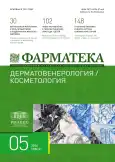Hidradenitis suppurativa: on the issue of rational therapy
- Авторлар: Zilberberg N.V.1, Kokhan M.M.1, Kascheeva Y.V.1
-
Мекемелер:
- Ural Research Institute of Dermatovenereology and Immunopathology
- Шығарылым: Том 31, № 5 (2024)
- Беттер: 143-147
- Бөлім: Clinical case
- URL: https://journal-vniispk.ru/2073-4034/article/view/267813
- DOI: https://doi.org/10.18565/pharmateca.2024.5.143-147
- ID: 267813
Дәйексөз келтіру
Аннотация
The article presents a series of clinical cases of management of patients with chronic suppurative hidradenitis (CSH) in the Clinic of the Ural Research Institute of Dermatovenereology and Immunopathology. The modern classification of CSH according to Hurley (1989), with 3 degrees of severity of the disease, the most accepted in clinical practice, is presented. Standard therapy for CSH to date includes antibiotics of various groups, systemic retinoids, glucocorticosteroids, antiandrogenic drugs, active anti-inflammatory, antibacterial topical therapy. In the treatment of CSH, surgical interventions are also used, which are most often implemented in the superficial opening of inflammatory foci, drainage of purulent tracts and sinuses, less often in local excision of foci and scars, including using laser surgery, which is carried out in the case of a long and severe course of CSH. At the same time, routine practice shows that the listed methods of therapy have only a moderate and temporary effect, without preventing further progradient development of the disease. The authors’ observations of patients with CSH presented in the article confirm this statement. With the clarification of the role of proinflammatory cytokines in the development of inflammation in CSH, the formation of fistulas and scars, new data on the significant role of proinflammatory cytokines in the pathogenesis of CSH, such as tumor necrosis factor α, interleukin-17 (IL-17), IL-1, IL-10, IL-23 have appeared. In practice, additional and effective agents from the class of genetically engineered biological preparations have appeared; they inhibit the above-mentioned cytokines and allow to significantly alleviate the course of the disease, which was demonstrated in a patient with a severe course of hidradenitis. The introduction of modern methods of therapy into clinical practice will significantly prolong clinical remission and improve the quality of life in patients of this group.
Толық мәтін
##article.viewOnOriginalSite##Авторлар туралы
N. Zilberberg
Ural Research Institute of Dermatovenereology and Immunopathology
Email: mkokhan@yandex.ru
ORCID iD: 0000-0002-7407-7575
Ресей, Yekaterinburg
M. Kokhan
Ural Research Institute of Dermatovenereology and Immunopathology
Хат алмасуға жауапты Автор.
Email: mkokhan@yandex.ru
ORCID iD: 0000-0001-6353-6644
Dr. Sci. (Med.), Professor, Head of the Scientific Clinical Department of Dermatology
Ресей, YekaterinburgYa. Kascheeva
Ural Research Institute of Dermatovenereology and Immunopathology
Email: mkokhan@yandex.ru
ORCID iD: 0000-0002-1974-3336
Ресей, Yekaterinburg
Әдебиет тізімі
- Олисова О.Ю., Соколовский Е.В., Хайрутдинов В.Р. и др. Гнойный гидраденит: определение, эпидемиология, этиология, диагностика (часть 1). Вестник дерматологии и венерологии. 2024;100(2):18–30. [Olisova O.Yu., Sokolovskiy E.V., Khairutdinov V.R., et al. Hidradenitis suppurativa: definition, epidemiology, etiology, diagnosis (part 1). Vestnik Dermatologii i Venerologii. 2024;100(2):18–30. (In Russ.)]. doi: 10.25208/vdv14876.
- Zouboulis C.C., Desai N., Emtestam L., et al. European S1 guideline for the treatment of hidradenitis suppurativa/acne inversa. J Eur Acad Dermatol Venereol. 2015;29(4):619–44. doi: 10.1111/jdv.12966.
- Hurley H. Axillary hyperhidrosis, apocrine bromhidrosis, hidradenitis suppurativa, and familial benign pemphigus: surgical approach. In: Roenigh R, Roenigh H, eds. Dermatologic surgery. New York: Marcel Dekker. 1989. Р. 729–39.
- Alikhan A., Sayed C., Alavi A.A., et al. North American clinical management guidelines for hidradenitis suppurativa: A publication from the United States and Canadian Hidradenitis Suppurativa Foundations: Part I: Diagnosis, evaluation, and the use of complementary and procedural management. J Am Acad Dermatol. 2019;81:76–90. doi: 10.1016/J.JAAD.2019.02.067.
- Gulliver W., Zouboulis C.C., Prens E., et al. T. Evidence-based approach to the treatment of hidradenitis suppurativa/acne inversa, based on the European guidelines for hidradenitis suppurativa. Rev Endocr Metab Disord. 2016;17:343–51. doi: 10.1007/s11154-016-9328-5.
- Vu D., Park M., Alhusayen R., Efficacy of Moxifloxacin as a Mono-antibiotic Therapy for Hidradenitis Suppurativa: A Retrospective Cohort Study. J Am Acad Dermatol. 2024. doi: https://doi.org/10.1016/j.jaad.2024.05.065.
- Wiala A., Daschl S.M., Stockinger T., et al. Oral fusidic acid for the treatment of mild-to-moderate hidradenitis suppurativa. Int J Dermatol. 2024;3. doi: 10.1111/ijd.17115.
- Miller A., Shahzeidi P., Bernhardt M. An Update on Current Clinical Management and Emerging Treatments in Hidradenitis Suppurativa. Skin Ther Lett. 2024;29(2).
- Хобейш М.М., Шустов Д.В., Соколовский Е.В. Гидраденит суппуративный: современные представления о патогенезе, терапии и успешный опыт лечения адалимумабом. Вестник дерматологии и венерологии. 2017;(5): 70–81. [Khobeysh M.M., Shustov D.V., Sokolovsky E.V. Hidradenitis suppurativa: modern concepts of pathogenesis, therapy and successful experience of treatment with adalimumab. Vestnik Dermatologii i Venerologii. 2017;(5):70–81. (In Russ.)]. doi: 10.25208/0042-4609-2017-93-5-70-81.
- Бурова С.А., Бородулина К.С. Гнойный гидраденит: вопросы патогенеза, оценочные шкалы, лечение (часть 2). Клиническая дерматология и венерология. 2019;18(3):265–69. [Burova S.A., Borodulina K.S. Hydradenitis suppurativa: issues of pathogenesis, rating scales, treatment. Overview (part 2). Russ J Clin Dermatol Venereol. 2019;18(3):265–69. (In Russ.)]. doi: 10.17116/klinderma201918031265.
- Nesbitt E., Clements S., Driscoll M. A concise clinician’s guide to therapy for hidradenitis suppurativa. Int J Womens Dermatol. 2019; 6(2):80–4. doi: 10.1016/j.ijwd.2019.11.004.
- Napolitano M., Timoshchuk M.M., Patruno C., et al. Hidradenitis suppurativa: from pathogenesis to diagnosis and treatment. Clin Cosmet Investig Dermatol. 2017;10:105–15 doi: 10.2147/CCID.S111019.
- Листок-вкладыш для пациента, Инструкция по применению препарата Хумира от 11.04.2023 г. Patient leaflet, Instructions for use of the drug Humira dated 11.04.2023. (In Russ.)]. URL: https://grls.rosminzdrav.ru/Grls_View_v2.aspx?routingGuid=418f3b14-da45-44fd-b620-f51e578cf817.
- Листок-вкладыш для пациента, Инструкция по применению препарата Далибра. ЛП-№(004250)-(РГ-RU)-110124 от 11.01.2024. [Patient leaflet, Instructions for use of the drug Dalibra. LP-No. (004250)-(RG-RU)-110124 dated 11.01.2024. (In Russ.)]. URL https://grls.rosminzdrav.ru/Grls_View_v2.aspx?routingGuid=a249929c-cf9e-4dc9-9ad3-e9a7a568ccc9.
- Zouboulis C.C., Okun M.M., Prens E.P., et al. Long-term adalimumab efficacy in patients with moderate-to-severe hidradenitis suppurativa/acne inversa: 3-year results of a phase 3 open-label extension study. J Am Acad Dermatol. 2019;80(1):60–9. doi: 10.1016/j.jaad.2018.05.040.
- Проект Клинические рекомендации «Гидраденит гнойный», Общероссийская общественная организация «Российское общество дерматовенерологов и косметологов». [Project Clinical guidelines «Purulent hidradenitis», All-Russian public organization «Russian Society of Dermatovenerologists and Cosmetologists». (In Russ.)]. URL: http://cnikvi.ru/klinicheskie-rekomendacii-rossijskogo-obshchestva/klinicheskie-rekomendacii/#proekty-klinicheskih-rekomendacij/dermatologiya.
- Snyder C.L., Gibson R.S., Porter M.L., Kimball A.B. Secukinumab in the treatment of hidradenitis suppurativa. Immunotherapy. 2023;15(17):1449–57. doi: 10.2217/imt-2023-0103.
Қосымша файлдар










